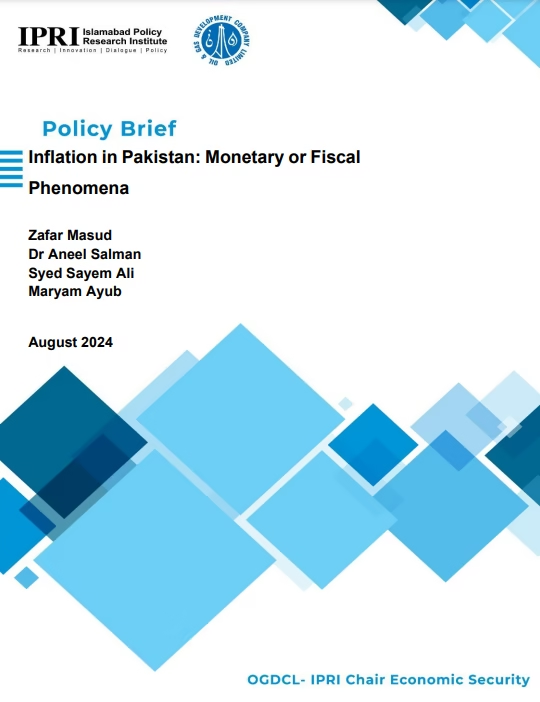Previous: Recent Inflationary Episode and the response of different countries — IPRI Policy Brief Pt 6
Proposed Framework for Controlling Inflation
High inflation can significantly reduce the purchasing power of fixed-income groups and financially weak households, exacerbating income inequality, eroding entrepreneurs’ competitiveness, and discouraging investment.
Therefore, controlling inflation is important for policymakers. Monetary policy is considered to be the only one responsible for maintaining the price stability of the country. The primary tool used by central banks around the world to control inflation is the sharp increase in interest rates and maintaining it for the year even if it results in a recession in the economy.
Similarly, in response to Post COVID inflationary episode, the SBP tightened its monetary policy by increasing the interest rate to tame inflation. The policy rate was kept at 22% for two consecutive years.
However, this constantly high interest rate affected the economy by affecting the investment climate of the country and raising the face value of debt owned by the country. Despite maintaining the stance of tight monetary policy for 2 years, rates of inflation did not seem to slow down nor did the inflation expectations of consumers and businesses improve.
This sparked a debate about whether inflation is truly a monetary phenomenon or whether inflation in Pakistan is fiscal-driven. Monetary policy lives under the shadow of debt, simply put, for countries with significant amounts of national debt where debt to GDP ratio is soaring, the maximum amount of government expenditure goes into interest servicing, and inflation becomes a fiscal issue as a 1% increase in interest rates increases their interest cost by 1%.
John Cochrane shifted the focus towards “fiscal inflation” and put forward the Fiscal Theory of Price level. The theory states that the present value of budget surpluses falls, goods and services in the country become expensive. Simply when the country’s debt keeps increasing the businesses and consumers lose confidence that the government will not be able to pay when the inflation rises.
The theory is of the view that the massive expansionary fiscal measures during COVID-19 resulted in recession in the economies worldwide. COVID stimulus checks resembled the helicopter drop, the countries did not transfer fresh money to the families in the form of support programs rather they introduced new debt equaling to the amount of emergency COVID support programs.
The theory states that in the presence of large fiscal debts and interest servicing, controlling inflation requires a blend of both monetary and fiscal policy in the right proportion in such a way that fiscal policy supports the stance of monetary policy.
Countries that managed to control the post-COVID inflation had well-coordinated fiscal and monetary policies. The theory advocates the reversal of roles of monetary and fiscal policy and wants fiscal policy to come into play at the front foot and monetary policy following the way of fiscal policy.
In monetary policy decision-making, while setting the policy rate, the market expectations of future inflation and policy rate must be considered as the expectations about future policy rate drive long-term interest rates and asset values which eventually influence the economic activity and prices.
For the monetary policy to be effective, market expectations of future policy rates must be aligned with the actual policy rate. Getting businesses’ inflation expectations in line with the inflation target, and stabilisation of inflation around its target become easy. 1
Incorporating expectations successfully and implementing an effective monetary policy is impossible without conveying the policy goals and objectives to the general public and businesses. Transparency is a key mechanism for improving central bank accountability, which is the foundation of central bank independence.
Additionally, transparency lowers the informational imbalance between the private sector and the central bank. Following the central banks worldwide, SBP shifted towards a relatively transparent monetary policy. SBP publishes a Monetary Policy Statement (MPS) briefly explaining the decisions taken by the Monetary Policy Committee (MPC).
However, the minutes of the MPC are published for the general public after a significant time lag and lack of information regarding the voting preferences of all members of the committee. SBP needs to improve transparency by publishing the minutes of MPC and by discussing the rationale behind the voting preference of all members of the Committee.
Moreover, the constitution of MPC needs to be reassessed as the decision-making completely rests on the discretion of the governor of the SBP.
The Monetary Policy Department makes policy decisions based on comprehensive forecasting models. Based on the data from the Consumer Confidence Survey (CCS), business Confidence Survey and IMF framework of forecasting inflation forecast of major economic variables including inflation, exchange rate, imports and exports and money demand etc are presented to MPC.
Additionally, the research department uses the Forecasting and Policy Analysis System and New Keynesian Dynamic Stochastic General Equilibrium to forecast economic indicators including headline inflation, real interest rate gap, output gap and real bilateral exchange rate gap etc. Based on the forecast received from different models monetary policy decisions are taken. 2
Currently, MPC is targeting the Core inflation for decision-making. Since core inflation excludes food and energy prices, the SBP needs to monitor both headline and core inflation for policymaking decisions, as food and energy prices constitute a major portion of spending of consumers and their changing prices significantly affect consumer behaviour.
CPI is considered to be the true measure of inflation and is being used by many economies around the world. However, the Bureau of Economic Analysis in the USA publishes the Personal Consumption Expenditure Price Index (PCE) as a measure of inflation which is used by the Federal Reserve’s Federal Open Market Committee (FOMC) when it comes to interest rate decisions. PCE is an indicator of household consumption that examines price changes in the goods and services purchased by consumers. It reflects the consumption patterns of households and their economic wellbeing.
The PCE price index can accurately reflect changing consumer behaviour as well as capture inflation or deflation in the economy. 3
How CPI is better than the PCE price index lies in the differences between the two indices. Firstly, both indices are constructed using different index formulas referred to as “formula effect”. The PCE is constructed on Fisher’s Ideal Index model whereas, CPI is constructed on the Laspeyres formula.
Secondly, the weights assigned to CPI are based on household surveys and are revised yearly.
However, the PCE price index employs relative weights derived from business surveys. These weights are adjusted monthly to reflect how consumers substitute goods and services when prices change. These differences are known as the “weight effect”.
Lastly, some items in the PCE price index are not included in the CPI and some items of CPI are out of the scope of the PCE price index which is known as the “scope effect”.39 4
However, the building blocks of both indices are essentially the same. However, in the case of the USA’s economy, the CPI tends to overestimate the inflation relative to the target, while the PCE inflation has historically been closer to the target level.
This difference between CPI inflation and PCE inflation is attributed to the difference in the weights of the indices. Therefore, the PCE price index is used by the FED in its monetary policy decisions.40 Pakistan is currently using the CPI as a measure of inflation but it does not reflect the country’s economic reality and needs to be updated.
In addition to constructing the CPI for measuring inflation, SBP should develop a PCE price index that better captures changing consumer preferences and more appropriately reflects the economic reality of the country.
Up Next: IPRI Policy Recommendations / Conclusion — IPRI Policy Brief Pt 8 / Final
Inflation in Pakistan: Monetary or Fiscal Phenomena
IPRI — Islamabad Policy Research Institute
Policy Brief by
- Zafar Masud
- Dr. Aneel Salman
- Syed Sayam Ali
- Maryam Ayub
August 2024
OGDCL – IPRI Chair Economic Security

- Svensson, Lars EO. What rule for the Federal Reserve? Forecast targeting. No. w23993. National Bureau of Economic Research, 2017. accessed on 29 July 2024 ↩︎
- “Monetary Policy Decision-Making Process”, State Bank of Pakistan https://www.sbp.org.pk/m_policy/mp-deci-imp.asp accessed on 12 August 2024 ↩︎
- “Prices & Inflation”, Bureau of Economic Analysis. https://www.bea.gov/resources/learning-center/whatto-know-prices-inflation accessed on 12 Aug 2024 ↩︎
- McCully, Clinton P., Brian C. Moyer, and Kenneth J. Stewart. “Comparing the consumer price index and the personal consumption expenditures price index.” Survey of Current Business 87, no. 11 (2007): 26-33. 40 Hansen Sarah, “What’s the Difference between the CPI and PCE Indexes?” Morningstar, 2 May 2024. https://www.morningstar.com/markets/whats-difference-between-cpi-pce accessed on 8 August 2024 ↩︎
